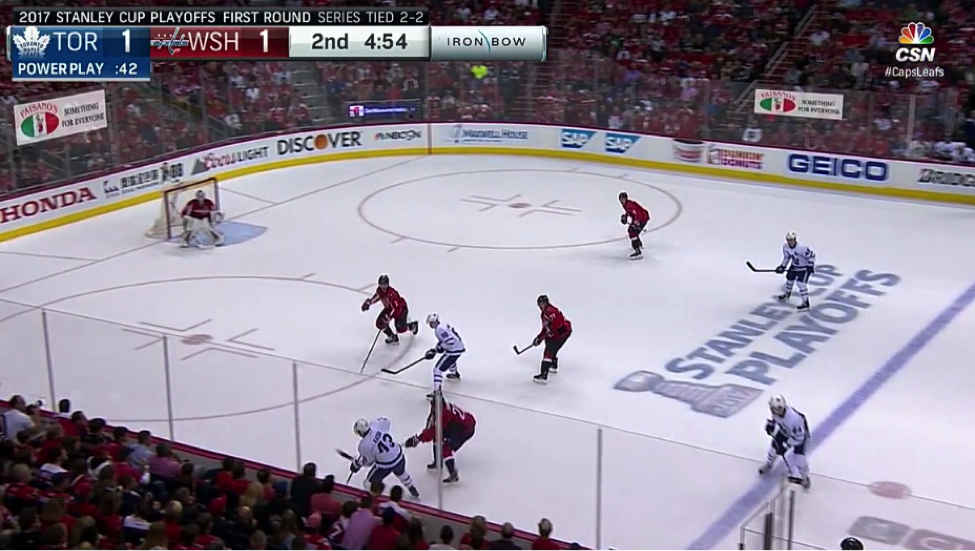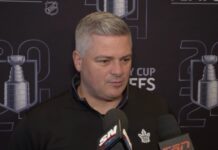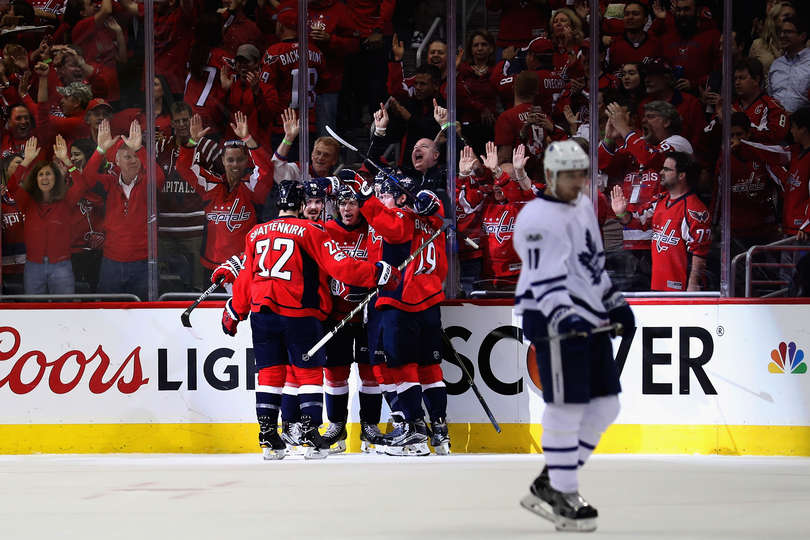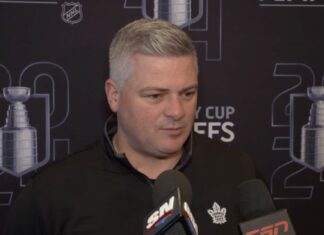One big reason the Leafs were successful in making the playoffs this season was their special teams. It went under the radar, but they actually ranked third in the NHL in combined power play and penalty kill efficiency.
The only problem is the Capitals ranked second.
This has been an incredibly tight series through five games. The goals are 16-15 in favour of Washington, the Capitals are also up slightly in shot attempts at 250-237, and both teams have 175 shots on goal. It doesn’t get much closer than that.
One area where the teams have been going in different directions is special teams, and that was a big storyline in Game 5 with the Leafs going 0/4 and Washington 1/3 in a 2-1 Capitals victory.
For the series, Washington has five goals on the PP and Toronto has three, so it’s not like there is a huge difference here. And let’s be honest, if you took any five-game stretch in a season and said a team scored three goals on the PP, nobody would say boo about it. But this is the playoffs and everything is magnified, especially when the series is so tight.
The real problem in Game 5 was their PPs were of the soul-sucking variety as they struggled to set up, create anything, or make Brayden Holtby work. They had four shots on their four PPs overall.
When the Leafs have been able to set up their 1-3-1 and force the Capitals to retreat into their PK stance, their PP has been good. All three of the Leafs PP goals have come off of this – the Morgan Rielly point shot, the Tyler Bozak OT winner, the JVR shot off of Orlov and in – but the real issue is they are struggling to set that up consistently. When it’s bad, it’s really bad. And it was really bad in Game 5.
The Leafs PP breakout is no secret – the defenseman carries it up, backs off the forecheck, then drops it to a forward who either carries it in himself, passes to the winger standing still at the blue line for a chip play, or passes it across to the other forward coming with speed to do the same. It has been effective throughout the year and a big reason why the Leafs had one of the best PPs in the league. But Washington is playing it really well.
Here’s a quick screenshot of how Washington is creating a diamond between their blue line and center to take away all available options:

On this play, the Leafs dumped it in before Holtby stopped it behind the net and shot it down the ice himself.
Toronto’s outlet for the player receiving the drop pass has always been the winger on the blue line who usually takes the puck and tries to hit the player with speed driving the middle lane. Washington has taken that away very well while also pressuring the man on the blue line with the puck. Here is a look at that:

On this play, Kadri ended up dropping the puck to Rielly, and all the Caps forward covering Kadri (Daniel Winnik) did was stop and turn around. He was able to knock it off of Rielly on a play that almost resulted in a Washington shorthanded breakaway.
There were a few plays that did have success for Toronto to consider moving forward. Instead of the forward on the blue line chipping the puck or dropping it immediately, there were a few times when he actually skated it in deep in the zone himself, curled and set it up. JVR, Komarov and Brian Boyle all did this at one point or another in game five. If there is too much pressure on that player to do this, the Leafs have also generally found that if he lays a soft chip into the corner instead of trying to make a saucer pass to the forward driving the net, they can also get it back. On the odd occasion, the forward receiving the drop pass with speed has also been able to just skate it in himself.
The Leafs have made tiny adjustments to their breakout throughout the series – adding the double drop pass vs. their usual single drop, running a big pick on the Washington penalty killer at the blue line, and even the soft chip in the corner that has worked. In Game 5, Washington had their number, though. It will be up to Babcock and the coaching staff to find an answer.
On the PK, it has been much what we discussed before the series when we pre-scouted the Washington PP. Washington has five PP goals, all of which are a product of the top three players in their 1-3-1. Ovechkin has two PP goals from his spot, John Carlson walked right in for a slap shot goal of his own, Justin Williams scored a broken 5v3 goal off of a point shot, and TJ Oshie scored last night after Nicklas Backstrom was allowed to walk right in and shoot it off the half-wall, hitting the post before going to Oshie’s stick for an easy finish.
The Leafs are basically running four penalty killing forwards, mixed in with the odd shift from one other player (Brian Boyle for faceoffs generally). Those forwards are Komarov, Connor Brown, Kasperi Kapanen, and Zach Hyman. Pressuring the half-wall and point man on the PK is easier said than done as it requires excellent communication to rotate, a lot of stamina due to all the stops and starts, and great anticipation.
Through the five games, Washington has 22 shots on net, 14 of which have come off the stick of Ovechkin or Kevin Shattenkirk. They are also the two players that lead their PP in shots missed, to go along with Carlson, who actually only has the one shot on net that resulted in a goal.
Unlike the Leafs PP, Washington has been able to consistently set up and generate offense. At a minimum, their PPs have not been draining momentum. The Leafs are going to have to emphasize the importance of pressuring the half-wall and point and make Washington run their PP down low, which they have yet to do. Shuffling Zaitsev in, Polak out, and then Marincin back in has done them no favours for continuity on the PK so far, but they are going to have to buckle down moving forward here because Washington has been very productive.
You wouldn’t usually spend this much time talking special teams with only a -2 goal differential through five games, but the series is so tight that every little thing counts right now. It has been a chess match so far and Washington took the upper hand in game five. Now it’s the Leafs turn to counter.
Notes
– Thought the first period was the most tentative start to any game in the series so far. Shots were 5-5 through the first 11 minutes and both teams were really tight in the neutral zone with the only real scoring chance coming on a quick 2v1 in the first shift of the game for Brown and Komarov.
– The game was eventually ramped right up when Kadri took a run at Ovechkin, getting him below the hip (which would be classified as low). Ultimately, Ovechkin was okay, so I don’t want to get too far into it, but a few quick thoughts: Ovechkin has been running the Leafs all series, so I get that Kadri wants to get him back. I also get that if Kadri tries to square up Ovechkin at full speed shoulder-to-shoulder, he is going to get run over. There is at least a 50 pound differential between the two (Ovechkin listed at 239, Kadri at 188), so he has to get him a little lower. Kadri definitely straddles the line between clean and dirty, but he is not a player that targets knees. If Ovechkin was out long-term, I think we would have seen a suspension, but I’m not expecting anything (maybe a fine) given he came back almost immediately. Not saying that’s the right way to conduct business, but that’s how the league works.
– That was Frederik Andersen’s best game of the series. He didn’t have a chance on either of the Washington goals and he made a collection of great saves including robbing Williams in the slot late, Ovechkin in the slot in the second, challenging Burakovsky on a breakaway, and a great 2v1 save. He was getting some criticism for allowing five goals in game four, and he responded very well.
– We’ll see how Connor Carrick responds to only playing 6:31 on the night after getting walked by Andre Burakovsky that led to his breakaway. Carrick has firmly been their number six for months now, even when the Leafs have had injuries, and he gets no special teams time on either unit. He was also chirping back and forth with Tom Wilson when he did play in the first half of the game, and Wilson for his part took four penalties and also got benched.
– Carrick was not the only player that got beat off the rush – Zaitsev got walked by Matt Niskanen off the rush and Marinicin was toe dragged by TJ Oshie. The big thing for the Leafs in Game 5 is they backchecked very well. When their defense was getting beat, there was always a forward there to break up the play. This was also the first game with no real odd man rushes. The neutral zone was really tight and a lot of offense was generated going down the wall or off of a forecheck.
– Mentioned last game how the Caps have been getting the puck to the point and sending all three forwards to the net to create chaos on the point shot. I noticed in Game 5 that they started tweaking it a little bit and actually having a forward swing high for a third point shot option. That’s a bit of a different look from Washington to keep an eye on.
– Great play Matt Hunwick towards the end of the game to break up a mini 2v1 backdoor pass. He led the team in ice time after 40 minutes and ended up finishing third behind Gardiner and Rielly. Hunwick hasn’t done anything spectacular this series, but he has eaten minutes and done a good job at being a steady top four while Zaitsev struggles coming off of an injury and Polak is out for the year. It’s easy to forget about Hunwick with all the talent on the team, but he should be recognized for that.
– Matt Martin also had a solid game – he hit the crossbar in the second and also drew a penalty. He only played 7:46, which was the lowest among forwards, but he had some impact shifts. I was surprised to see the fourth line take an offensive zone draw with roughly 2:30 left in the third period of a tie game. Seemed like Babcock was already thinking about overtime and wanted to keep the lines rolling as much as possible to keep everybody fresh.
– On the Matthews goal, Nylander made an awesome play to fend off defender with his body and use one hand on his stick to poke the puck to space so he could retrieve it. Think any concerns about him being able to fight through tight checking can be put to bed at this point. He has had a great series so far.
– Matthews’ hands in tight were great on his goal. That play is a lot harder than he makes it look. In the third, he also had a great play to pick the puck up off the wall in his own zone with a defender pressuring him, and hit Nylander with a pass for a clean breakout. He led all Leafs forwards in PP and overall ice time.
– On the last goal, Matthew and the pre-scout have to know by now that when Washington gets the puck out of their zone, Jay Beagle is getting off the ice immediately for whoever he replaced on the line. That should be Matthews’ job to track that coming down the ice. The goal doesn’t just come down to one man as the two defensemen had a miscommunication behind the net. It was a collection of mistakes and mental errors.
5 Questions for Game 6
1. What adjustments do the Leafs make on the PP breakout? I think they’d be best served to work the soft chips into the corners and have two guys with speed get in there, while also skating it in more.
2. Will Boyle get some more PP time? The only reason he was on is because Kadri was in the box, but he looked good helping them gain the zone and he also ran a few picks on the PP to create space. He is also, of course, a mammoth in front of the net. He might not start on the PP, but if it’s going south again, he might get another look.
3. Will Soshnikov draw in for PK help? I’ll ask this again because I still think he’s one of their best PKers and their PK is struggling.
4. Does Babcock move any forwards around to spark the group? The Bozak line is under 45% possession for the series. While the Kadri line is getting the tough matchup, they also only have one goal in five games as a line. Trotz flipped Wilson and Connolly to spark their lines, but Babcock has generally kept everything status quo throughout the season. Does he keep that going, or try to change things up at some point?
5. Can the Leafs push it to Game 7?




![Sheldon Keefe Post Game, Leafs 3 vs. Bruins 2: “I loved [the Matthews] line, and I loved a lot about our game all the way through the lineup” Sheldon Keefe, Toronto Maple Leafs post game](https://mapleleafshotstove.com/wp-content/uploads/2024/04/keefe-pg-game-1-218x150.jpg)


























![Sheldon Keefe Post Game, Leafs 3 vs. Bruins 2: “I loved [the Matthews] line, and I loved a lot about our game all the way through the lineup” Sheldon Keefe, Toronto Maple Leafs post game](https://mapleleafshotstove.com/wp-content/uploads/2024/04/keefe-pg-game-1-100x70.jpg)



